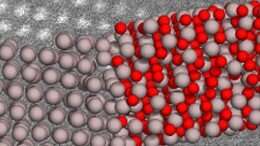Credit: Martin Cyster
There's more to glass than meets the eye.
Glasses, which are disordered materials with no long-range chemical order, have some mysterious properties that have remained enigmatic for several decades.
Amongst these are the anomalous vibrational states that contribute to the heat capacity at low temperature. Early researchers established that these states obey Bose-Einstein statistics, and the name stuck, so today this feature is known as the boson peak.
It is generally accepted that these vibrational states arise from the decay of bosonic phonon-like quasiparticles in the strong disordered glass environment.
Recent collaborative work between FLEET partners the University of Wollongong, RMIT and ANSTO have revealed the frequency of the boson-peak in the density of states of ultra-thin alumina with thicknesses of 2 nanometers.
Amorphous alumina is an important glass, used in the electronics industry as a dielectric layer, and within the emerging quantum computing sector where it plays the role of the barrier in a Josephson barrier junction.
Yet surprisingly, many of the fundamental properties of alumina remain unknown owing to the fact it is thermodynamically unstable at the macroscale.
The UoW /RMIT team overcame this issue by focusing on nanoscale glasses, in the context of core-shell particles of an aluminum sphere wrapped in a thin skin of its native alumina oxide. You can picture it as an hardboiled egg, with an internal aluminum solid "yolk" surrounded by a thin, external alumina shell.
Armed with these novel (and slightly explosive) samples, they deployed neutron spectroscopy at ANSTO—one of the FLEET partner organizations—to measure the lattice vibrations in the core shell particles.
By studying various particle sizes, the relative ratio of the core: shell was varied to allow for the group to separate the contributions of the "yolk" aluminum and from the alumina "shell."
Using the small particles to enhance the surface contrast, the group revealed a THz-frequency feature for the boson peak that is in good agreement with theoretical calculations.
"I was excited to see the match between the molecular dynamics performed by the Cole group and our neutron experiment," says lead author David Cortie. "Our ability to predict the vibrational and electronic properties of ultra-thin materials and heterointerfaces is getting better year-on-year."
As lattice vibrations are a leading source of dissipation in electronics, the new measurements are useful to identify methods to control heat transfer through ultra-thin alumina. This has also some other surprisingly implications outside of electronics, because the next generation of spacecraft for beyond Mars-expeditions may utilize aluminum/alumina fuels if the heat transfer issue can be reduced.
In a separate development, the group also found clear evidence for hydrogen in the form of H2O and hydroxyl groups whizzing around on the surface of the alumina, and reported a procedure to remove these native surface defects using a heat treatment procedure.
"We didn't set out to study hydrogen," says the lead co-author Jared Cole, "However, the fact that we observed it so clearly may be quite serendipitous. Hydrogen is an important surface impurity in quantum superconducting circuits, and experiments like this are a useful way to learn how it behaves, and how to mitigate its effects."
Normally hydrogen is nearly invisible to standard techniques, but neutrons scatter ten times more strongly from hydrogen than other elements because they interact with via nuclear forces rather than electromagnetic interactions. At ultra-low temperatures, quantum tunneling of hydrogen in two level systems is a candidate to explain the source of decoherence in leading quantum computing schemes.
The study, "Boson peak in ultrathin alumina layers investigated with neutron spectroscopy," was published in Physical Review Research.
More information: D. L. Cortie et al. Boson peak in ultrathin alumina layers investigated with neutron spectroscopy, Physical Review Research (2020). DOI: 10.1103/physrevresearch.2.023320
Provided by FLEET
























